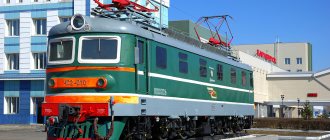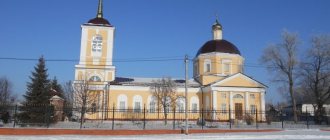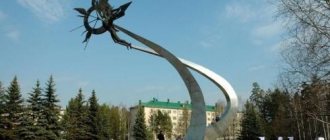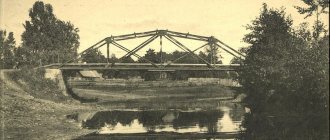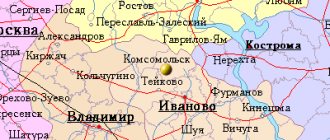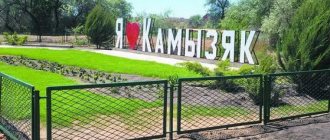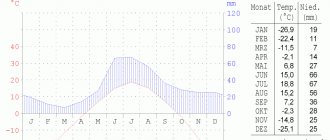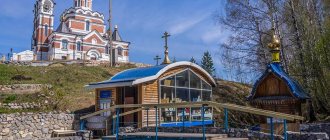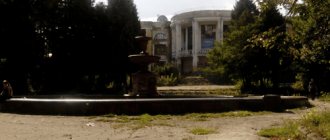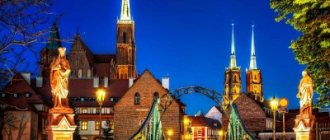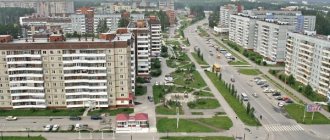This term has other meanings, see Tatarsk (meanings).
| City Tatarsk Flag |
| A country | Russia, Russia |
| Subject of the federation | Novosibirsk regionNovosibirsk region |
| Municipal district | Tatar |
| urban settlement | city of Tatarsk |
| Coordinates | 55°13′00″ n. w. 75°58′00″ E. d. / 55.21667° n. w. 75.96667° E. d. / 55.21667; 75.96667 (G) [www.openstreetmap.org/?mlat=55.21667&mlon=75.96667&zoom=12 (O)] (Z)Coordinates: 55°13′00″ N. w. 75°58′00″ E. d. / 55.21667° n. w. 75.96667° E. d. / 55.21667; 75.96667 (G) [www.openstreetmap.org/?mlat=55.21667&mlon=75.96667&zoom=12 (O)] (I) |
| Based | in 1894 |
| City with | 1911 |
| Population | ↘24,073[1] people (2016) |
| Names of residents | Tatars, Tatar |
| Timezone | UTC+7 |
| Telephone code | +7 38364 |
| Postcode | 632120,632126 |
| Vehicle code | 54, 154 |
| OKATO code | [classif.spb.ru/classificators/view/okt.php?st=A&kr=1&kod=50418 50 418] |
| Tatarsk Moscow |
| Novosibirsk Tatarsk |
Audio, photo and video
on Wikimedia Commons
K:Settlements founded in 1894
Tatarsk
- a city (since January 27, 1911) in Russia, the administrative center of the Tatar district of the Novosibirsk region.
Population - 24,073[1] people. (2016).
Story
Before 1917
The appearance of the city is associated with the construction of the Trans-Siberian Railway at the end of the 19th century. During the construction of the railway in 1894, the Tatarskaya station was formed, which received its name from the village of Tatarka, Kazatkul volost, Kainsky district, Tomsk province, located two miles from the station. The village of Tatarka, named after its first inhabitants, was founded in the 18th century: according to some sources, in 1733-1735 during the construction of the Moscow Highway[2], according to others, in 1790[3].
The station village developed rapidly due to the constant influx of settlers. Tatarsk became a transit point for displaced people; it housed the administration of the South Kainsky resettlement subdistrict, which housed a doctor, a canteen and two barracks, in which lived from 300 to 800 displaced persons awaiting departure to a new place of residence. In 1897, by decree of the emperor, the single-throne Church of St. Michael the Archangel [3] was built in Tatarsk, and in 1900 another church was built - the Nativity of Christ.
During the period of the Stolypin reforms, the influx of immigrants increased and by 1911 Tatarsk had turned into a solid trading post with a permanent population of 4,500 people[3].
As the settlement grew, the problems of water supply, medical care and lack of police became increasingly acute. In order to solve these problems, as well as to develop trade activities, the population of Tatarsk, first of all, the merchants, petitioned to transform the village into a city, which was followed on January 27, 1911 by the highest order “... to transform the village into a district-free city of Tatarsk in the Tomsk province with simplified city management"[4]. When the city was formed, a border was drawn between Tatarsk and the village of Starotatarsky, and the buildings that belonged to the merchant Lushnikov and the elder Kozhin ended up on the territory of Starotatarsky. The merchants wrote a complaint and gave a bribe of 1,000 rubles to the official Likhachev, after which changes were made to the draft city plan, which included the merchants' estates within the city limits[4]. In connection with the giving of a new status to the city, new officials appeared: the city mayor, the assistant to the mayor, the head of the police department, the head of the resettlement subdistrict, the butter-making instructor, the forester, the excise official, the instructor of city schools, the head of the postal and telegraph office, two justices of the peace (5 -th, 7th sections), agent of insurance companies[4].
In 1912-1914, the Kulundinskaya Mainline was built, which gave a new impetus to the further development of the city, turning it into a railway hub[3].
Before the start of the First World War, there were about 100 merchant shops and shops in the city. By that time, there were more than 15 butter purchasing offices in Tatarsk, which annually sent up to 300 thousand pounds of butter abroad and to the central regions of Russia[4]. The volume of bread supplies amounted to over a million poods of bread per year[4]. The brothers Sosnovsky, Mariupolsky, Zheltov, Borodin, Terekhov, Tsibis, Gusev, Lushnikov, Motskarev, Malygin, the Shaykhulin brothers, Kaspirovich and others were considered major merchants.[4]
The city developed food, forestry and other types of industries. The Zheltov brothers owned oil mills and held a monopoly on the trade in timber and lumber. The merchant Malygin owned an oil mill and a brick factory. Brick factories were also maintained by the merchants Gusev, Matveev, and Kishel. Merchant Chernov had a steam mill in the city (which burned down in 1963) and two windmills in the village of Tatarka. Another steam mill, located on the shore of Lake Tatar, belonged to the merchant Prader. Merchant Shpigelman owned an electric mill. There were two soap factories in the city, one of which belonged to the “company of employees” Shatina, and the other to the assistant to the city mayor Kuzmin[4].
Merchant Gusev in 1912 built a commercial club with a restaurant, which after the revolution housed a cinema named after Gorky (demolished in the 1980s). Merchants Shpigelman and Tsibis built a merchant building, which housed a grocery store and bakery during the Soviet period, then a garrison club, and later stores, nicknamed “the three little pigs” by local residents. The merchant Lushnikov built a hardware store with an outbuilding, which currently houses the “Old Post Office” store[4].
In 1913, the resettlement department sent two cars to Tatarsk, which became one of the first cars in the Tomsk province[3].
In December 1917, the rapidly growing city, by decision of the Council of People's Commissars of Soviet Russia, became the center of the Tatar district, newly created from the western volosts of the Kainsky district of the Tomsk province, with the addition of part of the volosts of the Akmola region [5]. A month later, the leaders of the Soviet government decide on the need to transfer the district to the Akmola region. However, the difficulties of the revolutionary time, turning into a state of the beginning of the Civil War, forced us to postpone the issue of transferring the district to the jurisdiction of a neighboring region. Tatarsk and the Tatar district will be part of the Tomsk province until 1919, until a special resolution of this issue by the Kolchak government.
After 1917
The Bolsheviks came to power in the city on December 16, 1917. The first chairman of the Council of Workers', Peasants' and Soldiers' Deputies was Makar Stepanovich Zakrievsky. However, with the outbreak of the Civil War, they failed to retain power in the city; the city and county came under white rule. Soviet power was finally re-established in the Tatar district on November 26, 1919, with the arrival of units of the 5th Red Army in the city[4].
Back in 1919, the Tatar district was reassigned to the Akmola region by the white authorities. The new Soviet government in the spring of 1920 formed the Omsk province and reassigned the district here. The population of the county was 264 thousand people. The district included 30 volosts and occupied a significant area - from Kyshtovka in the north to the Kulunda steppe in the south[3].
Tatar district
was abolished on August 13, 1925 with the formation of the Tatar region as part of the West Siberian Territory. The city of Tatarsk became a city of regional subordination and retained the status of an administrative center. According to the results of the All-Union Population Census of 1926, the permanent population in the city was 9.7 thousand people and continued to grow. By the beginning of the war, 25.6 thousand people lived permanently in the city. With the formation of the Novosibirsk region in 1937, Tatarsk and the Tatar region became part of this new region.
In the city of Tatarsk (Siberian Military District, (Novosibirsk region) on the basis of the 79th rifle division of the 73rd infantry division, the 109th rifle division was formed from April 15, 1939. In June 1939, the division moved to Kharanor. According to the directive of the USSR NCO dated December 7, 1939, it was reorganized to motorized.
Geography[ | ]
The city is located 457 kilometers west of Novosibirsk, near the border with the Omsk region. Railway junction (Tatarskaya station).
Climate[ | ]
The climate is temperate continental.
Winters are long and frosty. Summer is hot and short. Climate of Tatarsk (norm 1981—2010)
| Index | Jan. | Feb. | March | Apr. | May | June | July | Aug. | Sep. | Oct. | Nov. | Dec. | Year |
| Average temperature, °C | −16,9 | −15,5 | −7,7 | 3,1 | 12,1 | 17,3 | 19,5 | 16,6 | 10,1 | 3,2 | −7,7 | −14,4 | 1,6 |
| Precipitation rate | 19 | 16 | 14 | 20 | 34 | 48 | 64 | 54 | 38 | 28 | 32 | 26 | 393 |
| Source: [11]. | |||||||||||||
People associated with the city
- Starostenko, Vladimir Ivanovich (1948, Tatarsk) - 4th Minister of Railways of the Russian Federation
- Stepanchenko, Sergey Yurievich ((1959, Tatarsk) - People's Artist of the Russian Federation
- Telegin, Konstantin Fedorovich (1899, city of Tatarsk - 1981) - prominent Soviet military leader, lieutenant general
- Nyukhtilin, Vladimir Filippovich (1907, Tatarsk - 1980) - Soviet military pilot and military leader, participant in the Great Patriotic and Soviet-Japanese Wars, commander of the 18th mixed aviation corps, major general of aviation.
Notes[ | ]
- ↑ 123
The permanent population of the Russian Federation by municipalities as of January 1, 2022 (Russian). Retrieved April 27, 2022. Archived May 2, 2022. - Law of the Novosibirsk Region of June 2, 2004 No. 200-OZ “On the status and boundaries of municipalities of the Novosibirsk Region”
- Brief geographical and socio-economic characteristics of the Novosibirsk region
- Tatarsky district
- Pospelov, 2008, p. 433.
- Le Petit Fute: Novosibirsk region. Decree. op. - 2000. - P. 122.
- ↑ 1 2 3 4 5 6
Main dates in the history of Tatarsk
(unspecified)
. Access date: June 4, 2009. - ↑ 1 2 3 4 5 6 7 8 9
City of Tatarsk
(unspecified)
. Access date: June 4, 2009. - Resolution of the Department for Local Administration of the NKVD (Russian Soviet Republic) dated December 18 (31), 1917 No. 158 On the formation of 20 volosts of the Kainsky district, Tomsk province, and Trinity volost, Tyukalinsky district, an independent Tatar district, with the creation of a district center in mountains Tatarsk with its accession in political, administrative and economic relations to the Akmola region
- Information messages // Gazette of the Supreme Soviet of the USSR. - 1944. - No. 20 (280). — P. 4.
- FSBI "VNIIGMI-MCD".
- ↑ 12345678910
People's encyclopedia "My City". Tatarsk - All-Union Population Census of 1959. The size of the urban population of the RSFSR, its territorial units, urban settlements and urban areas by gender (Russian). Demoscope Weekly. Access date: September 25, 2013. Archived April 28, 2013.
- All-Union Population Census of 1970 The size of the urban population of the RSFSR, its territorial units, urban settlements and urban areas by gender. (Russian). Demoscope Weekly. Access date: September 25, 2013. Archived April 28, 2013.
- All-Union Population Census of 1979 The size of the urban population of the RSFSR, its territorial units, urban settlements and urban areas by gender. (Russian). Demoscope Weekly. Access date: September 25, 2013. Archived April 28, 2013.
- All-Union population census of 1989. Urban population (undefined)
. Archived from the original on August 22, 2011. - All-Russian population census 2002. Volume. 1, table 4. Population of Russia, federal districts, constituent entities of the Russian Federation, districts, urban settlements, rural settlements - regional centers and rural settlements with a population of 3 thousand or more (unspecified)
. Archived from the original on February 3, 2012. - Register of settlements of the Novosibirsk region (prepared by the department of organization of management of the administration of the Novosibirsk region). Newspaper “Soviet Siberia”, No. 146, July 31, 2007 (unspecified)
. Retrieved January 14, 2015. Archived January 14, 2015. - Cities of the Novosibirsk region (number of inhabitants - estimate as of January 1, 2008, thousand people) (unspecified)
. Retrieved May 23, 2016. Archived May 23, 2016. - The size of the permanent population of the Russian Federation by cities, urban-type settlements and regions as of January 1, 2009 (unspecified)
. Retrieved January 2, 2014. Archived January 2, 2014. - All-Russian population census 2010. Population of urban and rural settlements of the Novosibirsk region (unspecified)
. Access date: April 5, 2016. Archived April 5, 2016. - Population of the Russian Federation by municipalities. Table 35. Estimated resident population as of January 1, 2012 (unspecified)
. Retrieved May 31, 2014. Archived May 31, 2014. - Population of the Russian Federation by municipalities as of January 1, 2013. - M.: Federal State Statistics Service Rosstat, 2013. - 528 p. (Table 33. Population of urban districts, municipal districts, urban and rural settlements, urban settlements, rural settlements) (undefined)
. Retrieved November 16, 2013. Archived November 16, 2013. - Table 33. Population of the Russian Federation by municipalities as of January 1, 2014 (unspecified)
. Access date: August 2, 2014. Archived August 2, 2014. - Population of the Russian Federation by municipalities as of January 1, 2015 (unspecified)
. Access date: August 6, 2015. Archived August 6, 2015. - Population of the Russian Federation by municipalities as of January 1, 2016 (Russian) (October 5, 2018). Retrieved May 15, 2022. Archived May 8, 2022.
- Population of the Russian Federation by municipalities as of January 1, 2022 (Russian) (July 31, 2017). Retrieved July 31, 2022. Archived July 31, 2022.
- Population of the Russian Federation by municipalities as of January 1, 2022 (Russian). Retrieved July 25, 2018. Archived July 26, 2022.
- Population of the Russian Federation by municipalities as of January 1, 2022 (Russian). Retrieved July 31, 2019. Archived May 2, 2022.
- Population of the Russian Federation by municipalities as of January 1, 2022 (Russian). Date accessed: October 17, 2022. Archived October 17, 2022.
- taking into account the cities of Crimea
- https://rosstat.gov.ru/storage/mediabank/bul_Chislen_nasel_MO-01-01-2021.rar Population of the Russian Federation by municipalities as of January 1, 2022 (1.85 Mb, 07/30/2021)
Attractions
- Museum of History and Local Lore named after N.Ya. Savchenko
Photo gallery
- Tatarsk Uritsky street.jpg
Tatarsk Uritsky street
- Tatarsk St. Lenin 1.jpg
Tatarsk St. Lenin
- Tatarsk St. Lenin 2.jpg
Tatarsk St. Lenin
- Tatarsk Chimes.jpg
Chimes clock on the street. Lenin
- Tatarsk Monument to the village workers is dedicated.jpg
The monument “Dedicated to the village workers. 80 years of the Tatar district" on the street. Lenin
- Tatarsk Church of the Intercession of the Blessed Virgin Mary.jpg
Tatarsk Church of the Intercession of the Blessed Virgin Mary
External links [edit]
- Unofficial site of Tatarsk
| vteAdministrative divisions for the Novosibirsk region | |||
| Administrative center: Novosibirsk • Rural area. | |||
| Districts |
| ||
| Cities and towns |
| ||
| Urban settlements |
| ||
Excerpt characterizing Tatarsk
“I’m listening,” Gerasim said after thinking. Pierre spent the entire rest of that day alone in his benefactor's office, restlessly walking from one corner to another, as Gerasim heard, and talking to himself, and spent the night on the bed that was prepared for him right there. Gerasim, with the habit of a servant who had seen many strange things in his lifetime, accepted Pierre's relocation without surprise and seemed pleased that he had someone to serve. That same evening, without even asking himself why it was needed, he got Pierre a caftan and a hat and promised to buy the required pistol the next day. That evening Makar Alekseevich, slapping his galoshes, approached the door twice and stopped, looking ingratiatingly at Pierre. But as soon as Pierre turned to him, he bashfully and angrily wrapped his robe around him and hastily walked away. While Pierre, in a coachman's caftan, purchased and steamed for him by Gerasim, went with him to buy a pistol from the Sukharev Tower, he met the Rostovs. On the night of September 1, Kutuzov ordered the retreat of Russian troops through Moscow to the Ryazan road. The first troops moved into the night. The troops marching at night were in no hurry and moved slowly and sedately; but at dawn the moving troops, approaching the Dorogomilovsky Bridge, saw ahead of them, on the other side, crowding, hurrying across the bridge and on the other side rising and clogging the streets and alleys, and behind them - pressing, endless masses of troops. And causeless haste and anxiety took possession of the troops. Everything rushed forward to the bridge, onto the bridge, into the fords and into the boats. Kutuzov ordered to be taken around the back streets to the other side of Moscow. By ten o'clock in the morning on September 2, only the rearguard troops remained in the open air in the Dorogomilovsky Suburb. The army was already on the other side of Moscow and beyond Moscow. At the same time, at ten o’clock in the morning on September 2, Napoleon stood between his troops on Poklonnaya Hill and looked at the spectacle that opened before him. Starting from the 26th of August and until the 2nd of September, from the Battle of Borodino until the enemy entered Moscow, all the days of this alarming, this memorable week there was that extraordinary autumn weather that always surprises people, when the low sun warms hotter than in the spring, when everything sparkles in the rare, clean air so that it hurts the eyes, when the chest becomes stronger and fresher, inhaling the fragrant autumn air, when the nights are even warm and when in these dark warm nights golden stars constantly rain down from the sky, frightening and delighting. On September 2 at ten o'clock in the morning the weather was like this. The shine of the morning was magical. Moscow from Poklonnaya Hill spread out spaciously with its river, its gardens and churches and seemed to live its own life, trembling like stars with its domes in the rays of the sun. At the sight of a strange city with unprecedented forms of extraordinary architecture, Napoleon experienced that somewhat envious and restless curiosity that people experience when they see the forms of an alien life that does not know about them. Obviously, this city lived with all the forces of its life. By those indefinable signs by which at a long distance a living body is unmistakably distinguished from a dead one. Napoleon from Poklonnaya Hill saw the flutter of life in the city and felt, as it were, the breath of this large and beautiful body. – Cette ville Asiatique aux innombrables eglises, Moscow la sainte. La voila donc enfin, cette fameuse ville! Il etait temps, [This Asian city with countless churches, Moscow, their holy Moscow! Here it is, finally, this famous city! It's time!] - said Napoleon and, dismounting from his horse, ordered the plan of this Moscou to be laid out in front of him and called the translator Lelorgne d'Ideville. “Une ville occupee par l'ennemi ressemble a une fille qui a perdu son honneur, [A city occupied by the enemy is like a girl who has lost her virginity.] - he thought (as he said this to Tuchkov in Smolensk). And from this point of view, he looked at the oriental beauty lying in front of him, whom he had never seen before. It was strange to him that his long-standing desire, which seemed impossible to him, had finally come true. In the clear morning light he looked first at the city, then at the plan, checking the details of this city, and the certainty of possession excited and terrified him. “But how could it be otherwise? - he thought. - Here it is, this capital, at my feet, awaiting its fate. Where is Alexander now and what does he think? Strange, beautiful, majestic city! And strange and majestic this minute! In what light do I appear to them? - he thought about his troops. “Here it is, the reward for all these people of little faith,” he thought, looking around at those close to him and at the troops approaching and forming. – One word of mine, one movement of my hand, and this ancient capital of des Czars perished. Mais ma clemence est toujours prompte a descendre sur les vaincus. [kings. But my mercy is always ready to descend to the vanquished.] I must be generous and truly great. But no, it’s not true that I’m in Moscow, it suddenly occurred to him. “However, here she lies at my feet, playing and trembling with golden domes and crosses in the rays of the sun. But I will spare her. On the ancient monuments of barbarism and despotism I will write great words of justice and mercy... Alexander will understand this most painfully, I know him. (It seemed to Napoleon that the main significance of what was happening lay in his personal struggle with Alexander.) From the heights of the Kremlin - yes, this is the Kremlin, yes - I will give them the laws of justice, I will show them the meaning of true civilization, I will force generations the boyars lovingly remember the name of their conqueror. I will tell the deputation that I did not and do not want war; that I waged war only against the false policy of their court, that I love and respect Alexander, and that I will accept peace terms in Moscow worthy of me and my peoples. I do not want to take advantage of the happiness of war to humiliate the respected sovereign. Boyars - I will tell them: I do not want war, but I want peace and prosperity for all my subjects. However, I know that their presence will inspire me, and I will tell them as I always say: clearly, solemnly and grandly. But is it really true that I am in Moscow? Yes, here she is! “Qu'on m'amene les boyards, [Bring the boyars.],” he addressed the retinue. The general with a brilliant retinue immediately galloped after the boyars. Two hours passed. Napoleon had breakfast and again stood in the same place on Poklonnaya Hill, awaiting the deputation. His speech to the boyars was already clearly formed in his imagination. This speech was filled with dignity and the greatness that Napoleon understood. The tone of generosity in which Napoleon intended to act in Moscow captivated him. In his imagination, he appointed days for reunion dans le palais des Czars [meetings in the palace of the kings], where Russian nobles were to meet with the nobles of the French emperor. He mentally appointed a governor, one who would be able to attract the population to himself. Having learned that there were many charitable institutions in Moscow, he decided in his imagination that all these institutions would be showered with his favors. He thought that just as in Africa one had to sit in a burnous in a mosque, so in Moscow one had to be merciful, like the kings. And, in order to finally touch the hearts of the Russians, he, like every Frenchman, who cannot imagine anything sensitive without mentioning ma chere, ma tendre, ma pauvre mere, [my sweet, tender, poor mother], he decided that for everyone In these establishments he orders them to write in capital letters: Etablissement dedie a ma chere Mere. No, simply: Maison de ma Mere, [An institution dedicated to my dear mother... My mother’s house.] - he decided to himself. “But am I really in Moscow? Yes, here she is in front of me. But why hasn’t the city’s deputation been showing up for so long?” - he thought. Meanwhile, in the back of the emperor's retinue, an excited meeting was taking place in whispers between his generals and marshals. Those sent for the deputation returned with the news that Moscow was empty, that everyone had left and left it. The faces of those conferring were pale and agitated. It was not that Moscow was abandoned by the inhabitants (no matter how important this event seemed) that frightened them, but they were frightened by how to announce this to the emperor, how, without putting His Majesty in that terrible position, called by the French ridicule [ridiculous] , to announce to him that he had waited in vain for the boyars for so long, that there were crowds of drunken people, but no one else. Some said that it was necessary to gather at least some kind of deputation at all costs, others disputed this opinion and argued that it was necessary, having carefully and cleverly prepared the emperor, to tell him the truth. “Il faudra le lui dire tout de meme...” said the gentlemen of the retinue. - Mais, messieurs... [However, we must tell him... But, gentlemen...] - The situation was all the more difficult because the emperor, pondering his plans for generosity, patiently walked back and forth in front of the plan, glancing occasionally from under his arm on the way to Moscow and cheerfully and smiling proudly. “Mais c'est impossible... [But it’s awkward... Impossible...],” the gentlemen of the retinue said, shrugging their shoulders, not daring to utter the implied terrible word: le ridicule... Meanwhile, the emperor, tired of vain waiting and feeling with his acting instinct that the majestic moment, going on for too long, it begins to lose its majesty, he made a sign with his hand. A single shot of a signal cannon was heard, and the troops, besieging Moscow from different sides, moved to Moscow, to the Tverskaya, Kaluga and Dorogomilovskaya outposts. Faster and faster, overtaking one another, at a quick step and at a trot, the troops moved, hiding in the clouds of dust they raised and filling the air with the merging roar of cries. Carried away by the movement of the troops, Napoleon rode with his troops to the Dorogomilovskaya outpost, but stopped there again and, dismounting from his horse, walked for a long time near the Chambers of the Collegiate Wall, waiting for the deputation. Moscow, meanwhile, was empty. There were still people in it, a fiftieth of all the former inhabitants still remained in it, but it was empty. It was empty, just as a dying, exhausted hive is empty. There is no longer any life in a dehumidified hive, but at a superficial glance it seems just as alive as the others. The bees hover just as happily in the hot rays of the midday sun around the dehumed hive, as around other living hives; it also smells like honey from afar, and bees fly in and out of it. But it’s worth taking a closer look at it to understand that there is no longer life in this hive. Bees fly differently than in living hives; the wrong smell, the wrong sound amazes the beekeeper. When a beekeeper knocks on the wall of a sick hive, instead of the previous, instant, friendly response, the hiss of tens of thousands of bees, menacingly pressing their butts and quickly beating their wings producing this airy vital sound, he is answered by scattered buzzing sounds echoing in different places of the empty hive. From the entrance there is no smell, as before, of the alcoholic, fragrant smell of honey and poison, it does not bring from there the warmth of fullness, and the smell of emptiness and rot merges with the smell of honey. At the entrance there are no more guards preparing to die for protection, raising their butts in the air, trumpeting the alarm. There is no longer that even and quiet sound, the fluttering of labor, similar to the sound of boiling, but the awkward, disjointed noise of disorder is heard. Black oblong robber bees, smeared with honey, timidly and evasively fly in and out of the hive; they do not sting, but escape from danger. Previously, they only flew in with burdens, and empty bees flew out, now they fly out with burdens. The beekeeper opens the bottom well and peers into the lower part of the hive. Instead of the previously black lashes of succulent bees, pacified by labor, holding each other’s legs and pulling the foundation with a continuous whisper of labor, sleepy, shriveled bees wander in different directions absent-mindedly along the bottom and walls of the hive. Instead of a floor cleanly sealed with glue and swept away by fans of wings, at the bottom lie crumbs of wax, bee excrement, half-dead bees, barely moving their legs, and completely dead, untidy bees. The beekeeper opens the top well and examines the head of the hive. Instead of continuous rows of bees, clinging to all the spaces of the honeycombs and warming the babies, he sees the skillful, complex work of the honeycombs, but no longer in the form of virginity in which it was before. Everything is neglected and dirty. Robbers - black bees - scurry quickly and stealthily around the work; their bees, shriveled, short, lethargic, as if old, slowly wander, not bothering anyone, not wanting anything and having lost consciousness of life. Drones, hornets, bumblebees, and butterflies knock stupidly on the walls of the hive in flight. In some places, between the wax fields with dead children and honey, angry grumbling is occasionally heard from different sides; somewhere two bees, out of old habit and memory, cleaning the nest of the hive, diligently, beyond their strength, drag away a dead bee or bumblebee, not knowing why they are doing this. In another corner, two other old bees are lazily fighting, or cleaning themselves, or feeding one another, not knowing whether they are doing it in a hostile or friendly manner. In the third place, a crowd of bees, crushing each other, attacks some victim and beats and strangles it. And the weakened or killed bee slowly, lightly, like fluff, falls from above into a pile of corpses. The beekeeper unfolds the two middle foundations to see the nest. Instead of the previous solid black circles of thousands of bees sitting back and forth and observing the highest secrets of their native work, he sees hundreds of dull, half-dead and sleeping skeletons of bees. Almost all of them died, without knowing it, sitting on the shrine that they cherished and which no longer exists. They smell of rot and death. Only some of them move, rise, sluggishly fly and sit on the enemy’s hand, unable to die, stinging him - the rest, dead, like fish scales, easily fall down. The beekeeper closes the well, marks the block with chalk and, having chosen the time, breaks it out and burns it.
Population[ | ]
| Population | ||||||
| 1926[12] | 1931[12] | 1959[13] | 1967[12] | 1970[14] | 1979[15] | 1989[16] |
| 9200 | ↘9000 | ↗30 786 | ↘29 000 | ↗29 589 | ↗30 893 | ↘30 355 |
| 1992[12] | 1996[12] | 1998[12] | 2002[17] | 2003[12] | 2005[12] | 2006[12] |
| ↗30 800 | ↘30 400 | ↘30 300 | ↘26 051 | ↗26 100 | ↗26 200 | ↗26 300 |
| 2007[18] | 2008[19] | 2009[20] | 2010[21] | 2011[12] | 2012[22] | 2013[23] |
| ↘26 293 | ↘26 000 | ↗26 076 | ↘24 217 | ↘24 200 | ↘23 992 | ↗24 008 |
| 2014[24] | 2015[25] | 2016[26] | 2017[27] | 2018[28] | 2019[29] | 2020[30] |
| ↗24 165 | ↗24 208 | ↘24 073 | ↘23 956 | ↘23 729 | ↘23 523 | ↘23 376 |
| 2021[1] | ||||||
| ↘23 282 | ||||||
